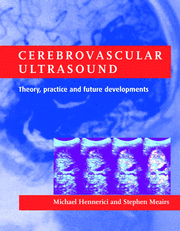Book contents
- Frontmatter
- Dedication
- Contents
- List of contributors
- Preface
- PART I ULTRASOUND PHYSICS, TECHNOLOGY AND HEMODYNAMICS
- PART II CLINICAL CEREBROVASCULAR ULTRASOUND
- (i) Atherosclerosis: pathogenesis, early assessment and follow-up with ultrasound
- 8 Morphogenesis of the atherosclerotic plaque
- 9 Hemodynamics and atherosclerosis
- 10 Carotid artery intima-media thickness
- 11 Non-invasive evaluation of endothelial function with B-mode ultrasound imaging of flow-induced brachial artery reactivity
- 12 Plaque characterization and risk profiles
- 13 Natural history of asymptotic carotid stenosis
- (ii) Extracranial cerebrovascular applications
- (iii) Intracranial cerebrovascular applications
- PART III NEW AND FUTURE DEVELOPMENTS
- Index
10 - Carotid artery intima-media thickness
from (i) - Atherosclerosis: pathogenesis, early assessment and follow-up with ultrasound
Published online by Cambridge University Press: 05 July 2014
- Frontmatter
- Dedication
- Contents
- List of contributors
- Preface
- PART I ULTRASOUND PHYSICS, TECHNOLOGY AND HEMODYNAMICS
- PART II CLINICAL CEREBROVASCULAR ULTRASOUND
- (i) Atherosclerosis: pathogenesis, early assessment and follow-up with ultrasound
- 8 Morphogenesis of the atherosclerotic plaque
- 9 Hemodynamics and atherosclerosis
- 10 Carotid artery intima-media thickness
- 11 Non-invasive evaluation of endothelial function with B-mode ultrasound imaging of flow-induced brachial artery reactivity
- 12 Plaque characterization and risk profiles
- 13 Natural history of asymptotic carotid stenosis
- (ii) Extracranial cerebrovascular applications
- (iii) Intracranial cerebrovascular applications
- PART III NEW AND FUTURE DEVELOPMENTS
- Index
Summary
Introduction
Although atherosclerotic cerebrovascular disease may remain asymptomatic for decades, its first manifestation as stroke can be severe, even deadly. Prevention of atherosclerotic disease or of its progression has, therefore, become an important goal in medicine. For the study of the prevention of atherosclerosis, it is necessary to assess not only the presence but also the severity of the disease in asymptomatic subjects. This requires an ethically acceptable technique that is safe, reliable, and relatively inexpensive. Most important, the method should provide morphological information of arterial walls at sites prone to atherosclerosis and allow surveillance of quantitative measurements of disease progress. These requirements for assessment of early cerebrovascular disease are met by high-resolution B-mode imaging of intima-media thickness (IMT) in the carotid arteries. This non-invasive technique has played a central role in many recent epidemiological studies and is being used increasingly for assessment of the efficacy of atherosclerosis prevention trials.
This chapter will summarize relevant pathophysiologic mechanisms leading to intima-media thickening, the nature of the ultrasonographic equivalent of IMT and methods for measurement of intima-media thickness. It will also outline sources of measurement variability, and hopefully provide a basis for interpretation of clinical studies using IMT as endpoints. It will then summarize current data on normal distribution values for IMT in the carotid arteries and on risk factors associated with increased IMT. This approach will serve as a framework for dealing with relevant questions on the value of IMT measurements and for elucidation of future goals in IMT research.
- Type
- Chapter
- Information
- Cerebrovascular UltrasoundTheory, Practice and Future Developments, pp. 152 - 161Publisher: Cambridge University PressPrint publication year: 2001
- 1
- Cited by



